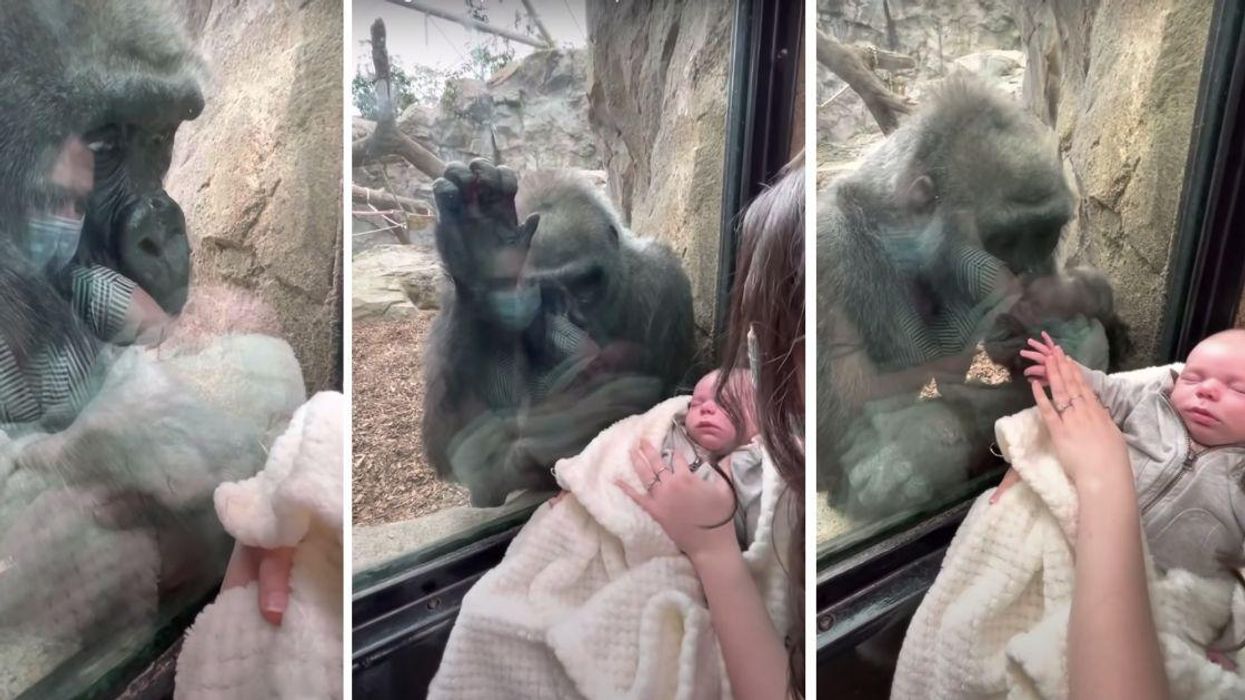
Humans and gorillas may look and live quite differently, but we share a whopping 98% of the same genes. Of all mammals on Earth, only the bonobo chimpanzee is closer to humans in terms of genetic makeup.
A viral video of an interaction with a gorilla mom at the Franklin Park Zoo in Boston has people marveling at the maternal similarities we share with the primates. The video shows Emmelina Austin kneeling in front of the glass barrier of the gorilla enclosure, holding her sleeping 5-week-old son, Canyon. The gorilla mom, Kiki, who gave birth to her own son, Pablo, via c-section in October, comes and sits right up close to Austin, gazing at the newborn and gently touching the glass as if she wants to touch the baby.
The video, shared by Emmelina’s husband Michael Austin, shows Kiki sitting close to Canyon for nearly five minutes. At one point, she moves her body out of the way as if to show off her own baby, who is standing behind her. It’s almost like you can hear her saying, “Enjoy this sleepy newborn phase while it lasts. Soon he’ll be running around like my little rascal here.”
“Her face was just so in love,” Austin told News Center Maine. “She was showing her baby my baby.”
“I was just in awe,” she said. “Trying to pet his face through the glass, and trying to hold his hand … just the most beautiful thing. You could see the emotion in her eyes.”
The whole video is just incredibly sweet.
Mother shares unique maternal bond with gorilla (FULL VIDEO)
www.youtube.com
Of course, the sweetness of the interaction is colored by the controversy of keeping primates in captivity. Some people feel that keeping any animals in captivity is wrong and have ethical issues with zoos in general. However, the reality is often not so simple. For one, interactions like this one can lead people to care more about gorillas in the wild, as people see up close how connected we are.
Many animals that are kept in captivity are unable to safely be released into the wild, and observing and studying animals in zoos can help scientists learn how to improve the lives of their counterparts in the wild. In addition, focused breeding programs in some zoos have led to the successful reintroduction of endangered species to the wild and increased numbers that were dwindling close to extinction. As Dr. Robin Gannert, president and CEO of the American Human Association, wrote, “Blunt and sweeping indictments of zoos and aquariums fail to account for how ethical institutions enrich and ultimately protect the lives of animals, both in human care and in the wild. Responsible zoos and aquariums exist to facilitate and promote the conservation of animals.” Zoos also work in concert with conservation groups such as the Dian Fossey Gorilla Fund International, which is one of the most well-known gorilla advocacy organizations in the world.
Franklin Park Zoo announced in March that a new $8.1 million gorilla habitat will be unveiled this summer, giving the zoo’s six gorillas a 360,000 cubic foot space to enjoy. Western lowland gorillas are critically endangered in the wild, and cooperative, inter-zoo programs like the Gorilla Species Survival Plan (SSP) help ensure the survival of endangered species in zoos and aquariums as well as support conservation efforts in the wild.
“We are thrilled to open the new outdoor gorilla exhibit, which will be an enriching experience not just for the gorillas, but for our guests as well,” said John Linehan, Zoo New England President and CEO in a statement. “We want to reach people through their hearts to build empathy for wildlife and habitats. As you observe the tender moments between a gorilla mom and her baby, or gorilla siblings playing together, you develop a better understanding of the family dynamics and social structure of these animals. Through this opportunity, guests can also better understand the importance of biodiversity and ecosystem health.”
However people feel about animals in zoos, this interaction between Kiki and baby Canyon should prompt all of us to do more to protect these magnificent creatures.
